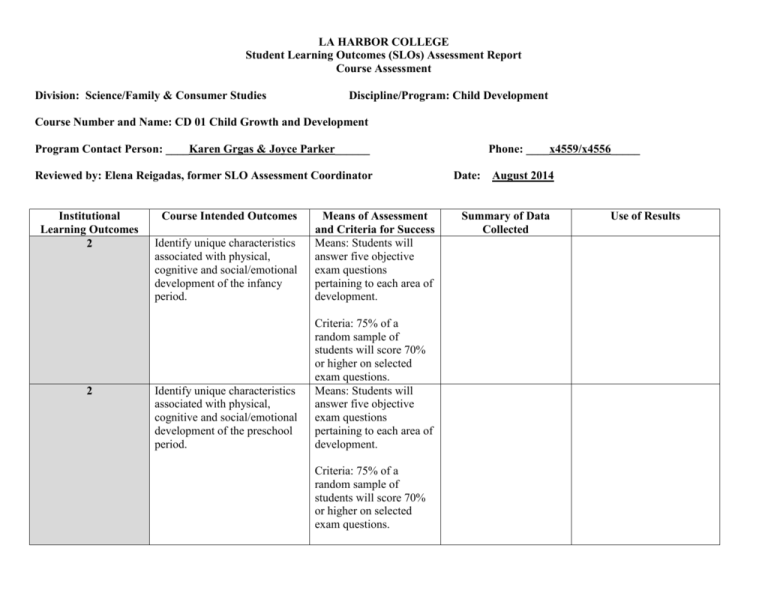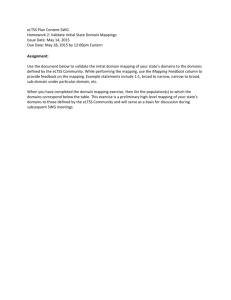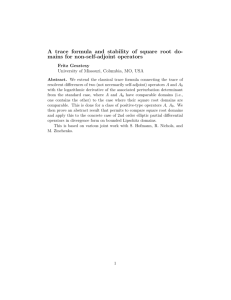Assessment Form
advertisement

LA HARBOR COLLEGE Student Learning Outcomes (SLOs) Assessment Report Course Assessment Division: Science/Family & Consumer Studies Discipline/Program: Child Development Course Number and Name: CD 01 Child Growth and Development Program Contact Person: ____Karen Grgas & Joyce Parker______ Reviewed by: Elena Reigadas, former SLO Assessment Coordinator Institutional Learning Outcomes 2 2 Course Intended Outcomes Identify unique characteristics associated with physical, cognitive and social/emotional development of the infancy period. Means of Assessment and Criteria for Success Means: Students will answer five objective exam questions pertaining to each area of development. Identify unique characteristics associated with physical, cognitive and social/emotional development of the preschool period. Criteria: 75% of a random sample of students will score 70% or higher on selected exam questions. Means: Students will answer five objective exam questions pertaining to each area of development. Criteria: 75% of a random sample of students will score 70% or higher on selected exam questions. Phone: ____x4559/x4556_____ Date: August 2014 Summary of Data Collected Use of Results 2 2 3 Identify unique characteristics associated with physical, cognitive and social/emotional development of the middle childhood period. Means: Students will answer five objective exam questions pertaining to each area of development. Identify unique characteristics associated with physical, cognitive and social/emotional development of the adolescent period. Criteria: 75% of a random sample of students will score 70% or higher on selected exam questions. Means: Students will answer five objective exam questions pertaining to each area of development. Use valid research techniques to identify cultural beliefs related to human development. Criteria: 75% of a random sample of students will score 70% or higher on selected exam questions. Means: Students will use valid research methods to obtain information to compile a written response to a specific prompt. Criteria: 75% of a random sample of students will score 70% or higher based on an assignment specific grading rubric. To be assessed Fall 2014 4 Select hereditary and environmental factors that impact human development. Means: Students will list five hereditary and five environmental factors that impact prenatal development. Criteria: 75% of a random sample of students will score 70% or higher on said assignment. Date: June 2011 Attach additional pages as necessary. Institutional Course Intended Outcomes Learning Outcomes (1)Relate the theoretical 1 perspectives that have guided thinking and research in child development to the theorists responsible for each theory and the key assumptions that define each theory. 1 (2) Compare and contrast the role of nature and nurture in human development. 1 (3) Identify the key terms and principles in physical, cognitive, and social/personality development during the infancy period of human growth. Means of Assessment and Criteria for Success Means: Students will match nine (9) theories to the theorist responsible for each as well as the key assumptions that define each theory. Criteria: 75% of students will score a grade of C (70%) or better. Means: Students will list three (3) characteristics associated with nature (innate human qualities) and three (3) characteristics associated with nurture (personal experiences). Short essay: Students will compare and contrast the role that each play in human development. Criteria: 75% of students will score a grade of C (70%) or better as determined by a class rubric. Means: Students will answer five (5) questions in each of the three (3) developmental domains (physical, cognitive, and social/personality). These Summary of Data Collected Spring 2011 70% of students tested earned a grade of C or better. Sample: 20 students randomly selected. Use of Results Groups will be assigned one of nine theorists to apply key terms and assumptions to a hypothetical situation involving a child to reinforce the major aspects of a child development theory. Fall 2011 Spring 2011 75% of students tested earned an overall (3 domains) grade of C or better. Students will view DVDs on each of the domains, discuss each, and complete a worksheet to reinforce text material. questions are chosen randomly from a multiple choice test of fifty (50) questions. Criteria: 75% of students will score a grade of C or better in all domains. 1 1 (4) Identify the key terms and principles in physical, cognitive, and social/personality development during the early childhood period of human growth. (5) Identify the key terms and principles in physical, cognitive, and social/personality development during the middle childhood period of human growth. Means: Students will answer five (5) questions in each of the three (3) developmental domains (physical, cognitive, and social/personality). These questions are chosen randomly from a multiple choice test of fifty (50) questions. Criteria: 75% of students will score a grade of C (70%) or better in all domains. Means: Students will answer five (5) questions in each of the three (3) developmental domains (physical, cognitive, social/personality). These questions are chosen randomly from a multiple choice test of fifty (50) questions. Criteria: 75% of students will score a grade of C (70%) or better in all domains. Individual domains: Physical 50% Cognitive 85% Soc/Per 75% earned a grade of C or better. Sample: 20 students randomly selected. Spring 2011 70% of students tested earned an overall (3 domains) grade of C or better. Individual domains: Physical 95% Cognitive 20% Soc/Per 85% Earned a grade of C or better. Students will view DVDs on each of the domains, discuss each, and complete a worksheet to reinforce text material. Sample: 20 students randomly selected. Spring 2011 65% of students tested earned an overall (3 domains) grade of C or better. Individual domains: Physical 75% Cognitive 60% Soc/Per 70% Sample: 20 students randomly selected. Students will view DVDs on each of the domains, discuss each, and complete a worksheet to reinforce text material. 1 (6) Identify the key terms and principles in physical, cognitive, and social/personality development in the adolescent period of human growth. Means: Students will Fall 2011 answer five (5) questions in each of the three (3) developmental domains (physical, cognitive, and social/personality). These questions are chosen randomly from a multiple choice test of fifty (50) questions. Criteria: 75% of students will score a grade of C (70%) or better in all domains.






